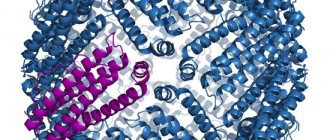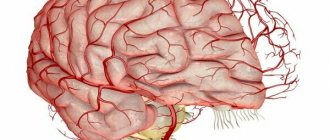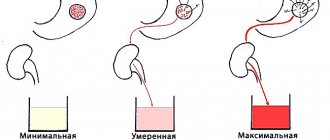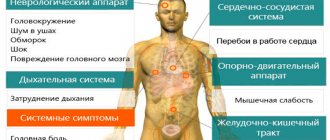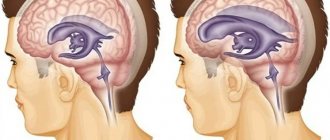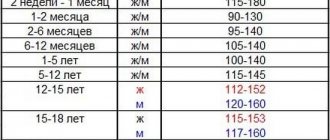The level of hemoglobin in the blood is one of the most important indicators of health, on which the saturation of the body’s cells with oxygen, necessary for metabolic processes, depends. When hemoglobin decreases, weakness, loss of strength, regular headaches and dizziness occur, so it is very important to monitor its level at home.
The importance of determining hemoglobin levels
Hemoglobin is an iron-containing protein found in red blood cells. It performs an extremely important function, ensuring the delivery of oxygen entering the blood to the tissues and cells of the internal organs.
When hemoglobin levels drop rapidly, cells do not receive enough oxygen, which negatively affects the functioning of the entire body.
The protein compound captures oxygen in the lung tissues and transports it to the body’s cells, ensuring their full functioning. Hemoglobin also captures and removes carbon dioxide from the body, which is a waste product.
Carbon dioxide accumulates in tissues, which leads to a deterioration in overall health and the development of such unpleasant symptoms as severe headaches, weakness, loss of strength, and pale skin. It is very important to promptly detect a decrease in hemoglobin and begin treatment. In its absence, complications such as a weakened immune system, tissue hypoxia, chronic insomnia, and heart failure may develop.
Hemoglobin norm depending on age
The normal level of iron-containing protein depends on several factors. It differs radically depending on the age and gender of a person. Before determining the amount of iron-containing protein in the blood, you need to familiarize yourself with the generally accepted reference values for this indicator.
- middle-aged men - 120-160 g/l;
- middle-aged women - 110-140 g/l;
- children under 6 months - 140-220 g/l;
- children from 6 months to 18 years - 95-140 g/l.
A decrease in hemoglobin levels below critical levels is called iron deficiency anemia and requires treatment. Correction of healthy protein levels can be carried out using medications containing iron or following a special diet.
To verify the reduced value, it is advisable to repeat the home measurement several times.
If all the results indicate a pathologically low level of hemoglobin, you should definitely consult a physician, since anemia can have dangerous consequences for the human body.
Laboratory diagnosis of anemia
Various indicators in the analysis may indicate iron deficiency in the body, but a diagnosis of anemia can only be made through a set of laboratory tests.
Usually, if anemia is suspected, the patient is prescribed general and biochemical blood tests, where the main indicators are:
Serum iron
– this indicator reflects the amount of iron in the bloodstream, the reserve level of iron reserves in tissues;
Ferritin
– biomarker of iron deficiency conditions. The protein ferritin accumulates iron reserves that were not used by red blood cells. The level of this reserve is very important to know, since depletion of reserves gradually leads to the development of anemia. The good news is that the decrease in ferritin occurs gradually and early diagnosis of a person will prevent the progression of anemia;
Transferrin
– will indicate iron metabolism, the cause and type of developing anemia;
Vitamin B12
– will help determine whether iron from food is absorbed. Long-term B12 deficiency is dangerous, since the vitamin is necessary for the formation of blood cells and the proper functioning of the nervous system;
Total iron binding capacity of serum (TIBC)
– determines the amount of iron in the body and its relationship with other proteins. TIHR is considered a stable indicator that indicates the circulation of iron regardless of nutrition during the day (iron levels change during the day, so it is important to correctly interpret the overall “picture” in the body);
Hemoglobin and red blood cell levels
– the average amount of hemoglobin in red blood cells. Changes in these indicators are the first “bells” for the patient and doctor about pathological changes in the body.
Depending on the general condition and complaints of the patient, the doctor may prescribe individual blood tests or a whole range of tests.
“Symptoms of anemia are often mistaken for chronic fatigue or overwork, but it is important to be on the alert: identify it and begin treatment. Ferritin is the most important indicator in diagnosing anemia,” comments LabQuest laboratory diagnostics expert Yulia Sergeevna Latynina.
Reasons for decreased hemoglobin
Hemoglobin in the blood can decrease for various reasons. Among the main factors that can provoke a lack of iron-containing protein, doctors identify:
- unbalanced diet with insufficient amounts of foods containing iron;
- excessively heavy or prolonged periods;
- abortion, childbirth or surgery accompanied by significant blood loss;
- hemorrhoids with bleeding;
- following a strict diet or fasting;
- diseases of the hematopoietic system;
- disruption of the absorption of iron in the intestinal cavity;
- lack of vitamin B12, necessary for the formation of hemoglobin in the body.
Common causes of iron deficiency anemia are diseases of the digestive system - chronic enteritis or atrophic gastritis, leukemia, benign or malignant neoplasms in the body.
The causes of a rapid decrease in hemoglobin levels can also be autoimmune and long-term infectious diseases - rheumatoid arthritis, systemic lupus erythematosus, tuberculosis, pneumonia, hepatitis. Many factors can cause the development of anemia; the exact cause can only be determined after a medical examination.
Determination of hemoglobin using the device
Today in the pharmacy chain you can find a wide selection of special devices designed to measure hemoglobin levels at home. Such a device is called a hemoglobinometer and is produced by several pharmacological companies.
Some of the most popular devices are MiniGem 540 and Easy Touch. Such hemoglobinometers allow you to determine protein levels in 10 seconds. Technique for performing home analysis:
- using a special needle from the set, pierce your finger;
- drop a few drops of blood into a test tube;
- add hydrochloric acid (included with the device);
- pour distilled water into the device - the liquid should take on the scarlet hue of blood;
- evaluate the result obtained on a special scale and compare it with the presented age norms.
The results of the study will be reliable only if you properly prepare for the procedure yourself. To do this, you must avoid any food or drink for at least 12 hours, and also stop taking any medications.
Additional functions of the meter
Typically, the device only measures the blood glucose concentration using a preset method. The kit includes the device itself, a set of test strips for the first time and a lancet for piercing the skin.
More expensive models come with statistical options, including separating measurements taken before and after meals. This is convenient for those who forget to fill out self-monitoring diaries.
A glucometer for an elderly or visually impaired person may have a voice assistant or a backlit display. The additional expense in this case is justified. You can also invest in an option with an auto-lancer, because not everyone has the fortitude to do it manually.
Options such as the ability to communicate with a computer or smartphone, the presence of extra control buttons and a timer are unimportant. Some sugar meters also analyze cholesterol levels.
Hemoglobin measurement with portable rapid tests
To measure hemoglobin levels at home, you can use simple and convenient test strips. Many manufacturers offer functional portable blood analyzers that measure not only iron protein levels, but also blood sugar and cholesterol. To do this you need to follow a few simple steps:
- wash your hands thoroughly;
- sit down and try to relax;
- Shake your hand for 2-3 seconds to activate blood circulation in your hand;
- lubricate your finger with alcohol;
- install the test strip with a connector specially designated for it - the device turns on in automatic mode;
- The device comes with a special pen with a needle, with which you need to puncture the treated finger;
- Apply a drop of blood from your finger to the control field of the strip.
Within a few seconds, information about the level of hemoglobin in the blood will appear on the device monitor. Many such devices are equipped with an electronic memory function, which allows them to record the obtained analysis result.
Types of glucometers
The classification is based on the operating principle of the device. Devices for measuring blood sugar levels are divided into invasive and non-invasive. The first involves pricking a finger and collecting capillary blood. They are:
- photometric;
- electrochemical;
- coulometric.
Express test strips are considered separately from invasive glucometers. This is not a device, but rather an indicator of sugar content. Although you also need to pierce your finger to use it.
For children and elderly patients, it is more convenient to use non-invasive ones. They do not require blood for analysis, so the measurement is absolutely painless. This category includes sensor devices (or Raman devices), including laser ones. They determine glucose levels based on subjective factors, so their accuracy is somewhat lower.
Main symptoms of iron deficiency anemia
You can determine a low hemoglobin level yourself, without special equipment. To do this, you need to pay attention to the characteristic signs that may indicate the development of iron deficiency anemia. The main manifestations of low hemoglobin:
- headaches accompanied by dizziness or fainting;
- noise in ears;
- pale or yellowing of the skin of the face and body;
- lethargy, weakness, loss of strength;
- loss of appetite;
- muscle pain;
- decreased immunity and frequent colds;
- cold extremities;
- change in taste preferences - the desire to eat chalk, raw dough, eggshells.
Iron deficiency anemia is accompanied by a decrease in blood pressure, constant shortness of breath, rapid heartbeat, and heart rhythm disturbances. Also, a decrease in iron-containing protein in the blood leads to indigestion, changes in the color and consistency of stool. A lack of hemoglobin can also be detected by a person’s appearance. His skin becomes dry, acquires a jaundiced or pale tint, the conjunctiva of the eyes turns red, hair and nails become brittle, and their growth slows down.
Test yourself! 10 obvious symptoms of iron deficiency
Immunity
Deficiency occurs when you don't have enough of the mineral iron in your body. Remember, your body, AT ANY AGE, needs iron to make hemoglobin, the protein in red blood cells that allows them to carry oxygen throughout the body.
If your body doesn't have enough hemoglobin, your tissues and muscles won't get enough oxygen to work effectively. This results in a condition called anemia. Although there are different types of anemia, iron deficiency anemia is the most common one worldwide.
Have questions about medications? Call and our consultants will answer! 8 (toll free)
Signs and symptoms of iron deficiency vary depending on:
- severity of anemia
- how quickly does it develop
- your age
- your current health status
Test yourself right now! Here are 10 signs and symptoms of iron deficiency, starting with the most common.
Most common symptoms
- Extreme fatigue (any time of the day).
Feeling very tired is one of the most common symptoms of iron deficiency. This symptom is more common in people who lack iron. This fatigue occurs because your body lacks the iron it needs to make a protein called hemoglobin, which helps carry oxygen throughout the body.
Without enough hemoglobin, less oxygen reaches tissues and muscles, depriving them of energy. Your heart also has to work harder to move more oxygen-rich blood around your body, which can make you feel tired.
Attention! Many people diagnosed with iron deficiency experience a lack of energy along with weakness, feelings of irritability, or difficulty concentrating.
- Paleness of the face.
Pale skin or pale coloring on the inside of the lower eyelids are other common signs of iron deficiency. Hemoglobin in red blood cells gives blood its red color, so low levels during iron deficiency make the blood less red. This is why the skin may lose its healthy color or glow in people with iron deficiency. This pallor in people with iron deficiency may appear throughout the body, or it may be limited to one area. For example:
- face (most often);
- gums;
- inside the lips or lower eyelids;
- nails (rare);
Pallor is more common in moderate or severe cases of anemia. If you pull your lower eyelid down, the inner layer should be bright red. If it is a very pale pink or yellow color, it may indicate that you have an iron deficiency. For people with darker skin tones, this may be the only area that is noticeable.
- Shortness of breath when walking quickly.
Hemoglobin allows your red blood cells to carry oxygen throughout your body. When hemoglobin levels are low during iron deficiency, oxygen levels will also be low. This means that your muscles will not receive enough oxygen to perform normal activities such as walking.
As a result, your breathing rate will increase as your body tries to get more oxygen. This is why shortness of breath is a common symptom. If you find yourself out of breath while doing normal daily tasks that you previously found easy, such as walking, climbing stairs, or working out, an iron deficiency may be to blame.
Buy dietary supplement Iron with plum flavor using the link:
Moderately common symptoms
- Headaches and dizziness.
Iron deficiency can cause headaches, especially in women. This symptom is less common than others, and often occurs specifically in the fairer sex. Headaches can occur due to low levels of hemoglobin in red blood cells, which means not enough oxygen is reaching the brain. As a result, blood vessels in the brain can swell, causing pressure and headaches.
- Cardiopalmus.
Less common, but another proven symptom of iron deficiency anemia. The link between iron deficiency, anemia and heart problems is still being studied, but it may be related to oxygen supply.
Hemoglobin is a protein in red blood cells that helps transport oxygen throughout the body. With iron deficiency, low hemoglobin levels mean the heart has to work extra hard to carry oxygen. This can lead to irregular heartbeats or the feeling that your heart is beating abnormally fast. In extreme cases, it can even lead to an enlarged heart, a heart murmur, or heart failure.
- Dry and damaged hair and skin
Dry and damaged skin and hair can be signs of iron deficiency. It lowers the level of hemoglobin in the blood, which can reduce the amount of oxygen available to the cells that cause hair growth. When skin and hair are deprived of oxygen, they can become dry and weak. Iron deficiency is also associated with hair loss, and some studies suggest that this may be a factor.
It is completely normal for some hair to fall out during daily washing and brushing. However, if you are losing clumps or much more than usual, it may be due to iron deficiency.
- Swelling and tenderness of the tongue and mouth
Sometimes just looking inside or around your mouth can tell you if you have iron deficiency anemia. For example, when your tongue becomes swollen, inflamed, pale, or strangely smooth. Iron deficiency can also cause other symptoms:
- dry mouth
- burning sensation in the mouth
- soreness, red cracks in the corners
- mouth ulcers
- "Restless Legs"
Iron deficiency has been linked to restless legs syndrome. This is a strong desire to move the legs while at rest. It can also cause an unpleasant and strange itching sensation in the feet and legs. It usually gets worse at night, which means you may have difficulty falling asleep. About 25% of people with iron deficiency anemia suffer from restless leg syndrome.
Write to us on WhatsApp for any questions!
Less common symptoms
- Brittle or spoon-shaped nails
A much less common symptom of iron deficiency is brittle or spoon-shaped nails. Usually the first sign is brittle nails that break and crack easily. In later stages of iron deficiency, spoon-shaped nails may occur, where the middle of the nail droops and the edges rise, giving a rounded, spoon-like appearance. However, this is a rare side effect that occurs in only about 5% of people with iron deficiency. This is usually seen only in severe cases of iron deficiency anemia.
- Other signs
There are several other signs that you may have low iron levels. They tend to be rare and can be associated with many other conditions besides iron deficiency. Other signs of iron deficiency anemia include:
- Strange desires. Cravings for strange foods or non-food items - The desire to eat ice, clay, dirt, chalk or paper and may be a sign of iron deficiency. This can also happen during pregnancy.
- Feeling depressed. Iron deficiency anemia may be associated with depression in adults.
- Cold hands and feet. Iron deficiency means less oxygen reaches your arms and legs. Some people may feel cold more easily in general or have cold hands and feet.
- More frequent infections. Because iron is essential for a healthy immune system, lack of iron can increase your risk of developing infections.
What to do if you suspect you have iron deficiency
If you think you have iron deficiency anemia, take these steps:
- Get a general blood test. A simple blood test can confirm whether you have iron deficiency anemia.
- Talk to your doctor. If a test confirms that you have an iron deficiency, it is usually fairly easy to treat. Your doctor will likely recommend increasing your iron intake from food and mineral supplements.
- Try to rebuild your diet. You need to eat more foods containing iron and take iron supplements regularly.
Buy dietary supplement Iron with vitamins with forest berry flavor:
Remember, the main goal of treatment is to restore normal hemoglobin levels and replenish iron stores, and subsequently maintain them. It's important to note that taking vitamin C will help your body absorb iron better. Try to eat enough foods rich in vitamin C.
Proper nutrition to increase hemoglobin
If your hemoglobin level is low, you should include as many iron-containing foods as possible in your diet.
| Healthy foods | Variety |
| Meat and offal | Beef, chicken, beef liver, tongue |
| Cereals | Buckwheat |
| Fish and seafood | Red fish, red caviar, shrimp, crabs, mussels, oysters, kelp |
| Eggs | Egg yolk |
| Fruits | Pomegranate, feijoa, plum, persimmon, apples, bananas, apricots, peaches |
| Berries | Cranberries, wild strawberries, raspberries, strawberries, blueberries, black currants, rose hips |
| Vegetables | Beets, carrots, beans, lentils, peas, pumpkin, tomatoes, potatoes, onions |
Various dried fruits can be an effective way to quickly increase hemoglobin at home. Raisins, apricots, and dried apricots contain a significantly higher concentration of iron than fresh fruits.
Consequences of low hemoglobin
Decreased immunity is a dangerous condition that cannot be ignored. It is accompanied by a serious deterioration in general well-being - a person is bothered by regular headaches, weakness, lethargy and loss of strength. In severe forms of iron deficiency anemia, severe dizziness and fainting may occur, attention disturbances, increased fatigue and muscle relaxation are often observed, which at an advanced stage can lead to urinary incontinence.
A decrease in hemoglobin below critical levels negatively affects not only a person’s well-being, but also his appearance.
As a result of lack of oxygen, skin, hair and nails dry out and become thinner, becoming dull and faded.
If iron-containing protein falls below normal, this negatively affects the immune system. As a result, a person is bothered by regular colds, as well as exacerbations of chronic diseases.
What is the problem?
For a device to be useful, it must not just be on the shelf, but used correctly. It happens that a person, wanting to save test strips, tries to rely on his own health to assess his sugar level. However, rarely can anyone feel fluctuations in sugar levels of 4-13 mmol/l, and most of the indicators are in these numbers. Even worse, a person who is accustomed to high glycemic levels feels relatively normal, and perceives a decrease in numbers to the correct values as a deterioration in well-being. This means you can’t rely on sensations.
Old age, decreased visual acuity, the presence of mental illness, dementia, rare visits to the doctor, all this reduces the effectiveness of self-control. Many people think that while in the hospital for the selection or correction of treatment, it is necessary to frequently measure the glucose level, but at home you can measure the blood glucose level in the morning after waking up and that is enough. Blood glucose should be measured on an empty stomach, before and after meals.
For type 1 diabetes mellitus, glucose is measured at least 4 times daily, sometimes adding 1 nightly measurement every 3 hours.
In type 2 diabetes mellitus, after diagnosis and during decompensation of the disease, measurements are taken several times a day. The frequency of monitoring is then determined by the type of treatment and the doctor.
The frequency of blood sugar monitoring is determined by the type of treatment and your doctor.
The American Diabetes Association recommends frequent blood glucose monitoring:
- pregnant women;
- people with unstable indicators, prone to severe forms of ketosis or hypoglycemia;
- receiving intensive insulin treatment;
- those who cannot recognize the symptoms of impending hypoglycemia in time;
- if the renal threshold for glucose is violated.
Then it is recommended to measure sugar 6-8 times a day, and if necessary, then at night.
Unfortunately, daily self-measuring of glucose seems to be an unpleasant and worrying procedure. You need to prick your finger yourself, apply the blood correctly to the test strip, and not spoil it. The complexity of operating the device and the price of test strips outweigh the recommendations of the attending physician. Then a situation is created where there is a device, or even more than one, but there is no control.
If you still want to take control of your sugar levels, then you should understand glucometers.
A few words about the role of hemoglobin
The hemoglobin level plays a very important role in the full functioning of the human body. This iron-containing protein supplies oxygen to the cells and tissues of internal organs, ensuring their normal functioning.
You can increase your hemoglobin level if it decreases with the help of a proper, balanced diet. Additionally, you can take pharmaceutical iron supplements, which will be prescribed by your doctor based on the results of a blood test.
